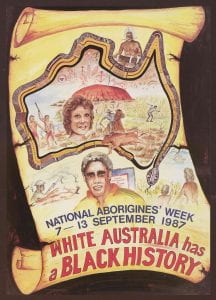‘Winja Ulupna’: Public Health Posters as Visual Culture
Ainslee Meredith
Winja Ulupna is an Aboriginal women’s residential drug and alcohol recovery house based in St Kilda. Established in 1976 through Australian Government investment in residential rehabilitation programs controlled by Aboriginal communities, as distinct from State rehabilitation units (Brady 2002), Winja Ulupna, or ‘women’s haven’, was also the first rehabilitation house in Australia specifically for Aboriginal women. As an early example of an Aboriginal women’s run program providing culturally sensitive alcohol and drug services, the poster highlights the importance of community-controlled residential programs in the broader context of a continued denial of the right of self-determination for Indigenous Australians by governments at that time. Designed by Health Productions in 1991 (the art department of the Health Promotion Unit, for the Government of Victoria), the poster is also significant in terms of the history of government-sponsored poster design to disseminate public health messages. Continue reading “‘Winja Ulupna’: Public Health Posters as Visual Culture”

